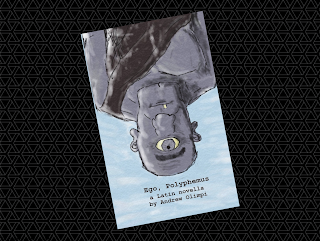Plūtō: Fābula Amōris
 Plūtō: Fābula Amōris (Pluto: A Love Story) is a sheltered-vocabulary Latin novella published by Rachel Ash and Miriam Patrick in 2015. It tells the story of Pluto, the lonely god of the underworld, and Proserpina, who becomes his queen. It is notable for its simple syntax—it has the lowest words per sentence of any novella—and for being one of the shortest novellas.
Plūtō: Fābula Amōris (Pluto: A Love Story) is a sheltered-vocabulary Latin novella published by Rachel Ash and Miriam Patrick in 2015. It tells the story of Pluto, the lonely god of the underworld, and Proserpina, who becomes his queen. It is notable for its simple syntax—it has the lowest words per sentence of any novella—and for being one of the shortest novellas.Available from Amazon.
Reading level
The blurb on the back cover states that this novella is “ideal for students in their first-second year of Latin study. Comprehensible Antiquity puts this novella at Level C, and gives a full review here.
Diverse & Multicultural Identities
For information about how representation of multicultural and diverse identities is analyzed in LNDb, see here.Parallel cultures
No depictions identified.Gender
Features one cis male main character (Pluto) and one cis female main character (Proserpina). Features no transgender main characters.Sexual identity
Features a depiction of heterosexual identity: Pluto and Proserpina get married.SES/class
No depictions identified.Religion
No depictions identified.Disability
No depictions identified.Language Statistics
Vocabulary
Word List
A complete word list for Plūtō: Fābula Amōris can be found here.
Glosses
This novella contains glosses in the form of both footnotes with English translations.
Of the 134 unique words (not counting proper nouns) used in the text, 16.0 of them (11.9%) are glossed at their first appearance in the text. Of the 1070 total words in the text, 18.0 of them (1.7%) are glossed.
Of the 134 unique words (not counting proper nouns) used in the text, 16.0 of them (11.9%) are glossed at their first appearance in the text. Of the 1070 total words in the text, 18.0 of them (1.7%) are glossed.
Glossary
This novella contains a Latin-English glossary, with every form of each word listed separately and grouped under a single definition. The glossary is complete.
Syntax
The ratio of complex sentences indicates what proportion of the total sentences are complex sentences, on average. A complex sentence is defined as a sentence with one or more subordinate clauses or verb phrases.
Summary
Genre & Sources
This novella is in the genre of mythological (Classical).
It is an adaptation of the story of Pluto and Proserpina, found in numerous Classical sources.
It is an adaptation of the story of Pluto and Proserpina, found in numerous Classical sources.
Complete Plot Summary
CONTAINS SPOILERS
Pluto is the god of the underworld, alone and loved by no one. Proserpina is the daughter of Ceres who does not want to marry. Pluto brings Proserpina to the underworld and keeps her there for three months. Proserpina grows to like Pluto. When her mother comes to bring her back, she decides to be his wife and stay with him for six months out of the year.
First 100 Words
Underlined words are glossed in the text.Ego sum deus. Sum deus mortuorum. Sum rex. Sum rex mortuorum. Nomen mihi est Pluto. Nemo me amat. Dei me non amant. Mortales me non amant. Nemo me amat. Sub terra habito. Dei in caelo habitant, ego sub terra. Nemo mecum habitat. Nemo sub terra habitare vult. Sum tristis.
Dei me puerum deridebant. Mihi non placebant. Fratrem habeo. Iuppiter vocatur. Iuppiter est rex mortalium. Iuppiter et dei me deridebant. Iuno, puella pulchra et soror mea, me deridebat. Iam dei sunt amici mei, sed nemo me amat.
Iam puer non sum. Sum deus. Sum rex. Sed tristis sum. Coniugem non habeo.
Supplementary Materials
One of the authors has published a teacher’s guide, available from Amazon.Presentation
| Illustrations? | yes |
| Illustrator | ? |
| Macrons? | no |
| Font | Times New Roman |
| Pages of story | 26 |
| Total pages | 34 |
| Chapters | 8 |
Key Information
| Publication date | May 4, 2016 |
| Publisher | Pomegranate Beginnings Publishing |
| ISBN | 0692706992 |
| ISBN-13 | 978-0692706992 |

